Spatial Distribution Characteristics of Soil Nutrients in the Ferralic Cambisols Watershed
Abstract
1. Introduction
2. Materials and Methods
2.1. Study Area
2.2. Soil Erosion Data
2.3. Sample Collection
2.4. Analytical Methods
2.5. Data Analysis
3. Results and Discussion
3.1. Characteristics of Soil Nutrients
3.2. Geostatistical Analysis of Soil Nutrients
3.2.1. Trend Analysis of Soil Nutrient
3.2.2. Soil Nutrient Semivariance Models
3.3. Kriging Interpolation of Soil Nutrients
3.3.1. Spatial Distribution of OM
3.3.2. Spatial Distribution of TN
3.3.3. Spatial Distribution of AN
3.3.4. Spatial Distribution of TP
3.3.5. Spatial Distribution of AP
3.4. Relationship Between Soil Erosion and Soil Nutrients
4. Conclusions
Supplementary Materials
Author Contributions
Funding
Data Availability Statement
Conflicts of Interest
References
- Wang, N.; He, H.; Lacroix, C.; Morris, C.; Liu, Z.; Ma, F. Soil fertility, leaf nutrients and their relationship in kiwifruit orchards of China’s central Shaanxi province. Soil Sci. Plant Nutr. 2019, 65, 369–376. [Google Scholar] [CrossRef]
- Xia, R.; Zhang, S.-Q.; Li, J.; Li, H.; Ge, L.-S.; Yuan, G.-L. Spatial distribution and quantitative identification of contributions for nutrient and beneficial elements in top- and sub-soil of Huairou District of Beijing, China. Ecol. Indic. 2023, 154, 110853. [Google Scholar] [CrossRef]
- Chaurasia, M.; Patel, K.; Bhadouria, R.; Rao, K.S. Spatial variability in soil physicochemical parameters across land use classes in the peri-urban landscape. Environ. Dev. Sustain. 2023, 26, 24791–24815. [Google Scholar] [CrossRef]
- Tian, M.; Sun, B.; Wu, C.; Cheng, X.; Zhou, G.; Huang, C.; Zhou, Y.; Hu, Q.; Li, L. Spatial distributions and the main driving factors of soil total nitrogen in Zhejiang Province, China. Geoderma 2024, 452, 117112. [Google Scholar] [CrossRef]
- Cao, Y.; Ouyang, Z.Y.; Zheng, H.; Huang, Z.G.; Wang, X.K.; Miao, H. Effects of forest plantations on rainfall redistribution and erosion in the red soil region of Southern China. Land Degrad. Dev. 2010, 19, 321–330. [Google Scholar] [CrossRef]
- Liang, Y.; Li, D.; Lu, X.; Yang, X.; Pan, X.; Mu, H.; Shi, D. Soil erosion changes over the past five decades in the red soil region of Southern China. J. Mt. Sci. 2010, 7, 92–99. [Google Scholar] [CrossRef]
- Wu, X.; Jiang, N.; Li, A.; Yang, Y.; Cheng, H. Spatial distribution pattern of soil organic matter in the wind erosion region of northeastern China based on the cokriging method. Catena 2025, 248, 108575. [Google Scholar] [CrossRef]
- Zhou, W.; Li, C.; Zhao, W.; Stringer, L.C.; Fu, B. Spatial distributions of soil nutrients affected by land use, topography and their interactions, in the Loess Plateau of China. Int. Soil Water Conserv. Res. 2024, 12, 227–239. [Google Scholar] [CrossRef]
- Webster, R. Quantitative Spatial Analysis of Soil in the Field. In Advances in Soil Science; Springer: New York, NY, USA, 1985; pp. 1–70. [Google Scholar]
- Webster, R.; Oliver, M.A. Optimal interpolation and isarithmic mapping of soil properties. VI. Disjunctive kriging and mapping the conditional porbability. J. Soil Sci. 1989, 40, 497–512. [Google Scholar] [CrossRef]
- Qi, G.; Lu, H.; Zang, Y.; Zhang, J.; Li, X.; Hu, X. Predicting Soil Organic Carbon Content by Combining Unmanned Aerial Vehicle Multispectral Images and Machine Learning Algorithms. J. Soil Sci. Plant Nutr. 2025, 25, 1–15. [Google Scholar] [CrossRef]
- Haefele, S.M.; Wopereis, M.C.S. Spatial variability of indigenous supplies for N, P and K and its impact on fertilizer strategies for irrigated rice in West Africa. Plant Soil 2005, 270, 57–72. [Google Scholar] [CrossRef]
- Cahn, M.D.; Hummel, J.W.; Brouer, B.H. Spatial Analysis of Soil Fertility for Site-Specific Crop Management. Soil Sci. Soc. Am. J. 1994, 58, 1240–1248. [Google Scholar] [CrossRef]
- Yost, R.S.; Uehara, G.; Fox, R.L. Geostatistical Analysis of Soil Chemical Properties of Large Land Areas. II. Kriging. Soil Sci. Soc. Am. J. 1982, 46, 1033–1037. [Google Scholar] [CrossRef]
- Gaston, L.A.; Locke, M.A.; Zablotowicz, R.M.; Reddy, K.N. Spatial Variability of Soil Properties and Weed Populations in the Mississippi Delta. Soil Sci. Soc. Am. J. 2001, 65, 449–459. [Google Scholar] [CrossRef]
- Chen, Z.; Chen, Z. Spatial misallocation of ecological restoration and resulting economic costs in the red soil hilly region of China: A case study of the Zhuxi watershed. Environ. Monit. Assess. 2020, 192, 125. [Google Scholar] [CrossRef]
- Chen, H.; Chen, H.; Chen, Z.; Chen, Z. The ecological impacts of residues from the heap leaching of ion-adsorption rare earth clays. Int. J. Environ. Sci. Technol. 2023, 20, 13267–13276. [Google Scholar] [CrossRef]
- Lu, R. Methods of Soil Agricultural Chemical Analysis; China Agricultural Science and Technology Press: Beijing, China, 2020. [Google Scholar]
- Ettema, C.H.; Wardle, D.A. Spatial soil ecology. Trends Ecol. Evol. 2002, 17, 177–183. [Google Scholar] [CrossRef]
- Sun, B.; Zhao, Q. Spatio-temporal variability of red soil ferility in low hilly region. Acta Pedol. Sin. 2002, 39, 190–198. [Google Scholar]
- Yan, P.; Zhou, P.; Lei, S.; Tan, Z.; Chen, H.; Huang, J. Spatial Distribution of Soil Nutrients in the Red Beds of Southern China and Their Responses to Different Land Use Types. Forests 2025, 16, 417. [Google Scholar] [CrossRef]
- Wang, D.; Huang, Y.; Wang, C.; Jiang, F.; Yan, F.; Yu, Y. Comprehensive evaluation of control benefits in granite areas with severe soil and water loss. Fujian Sci. Technol. Trop. Crops 2006, 31, 4–7. [Google Scholar]
- Tang, G.; Yang, X. Experimental Tutorial on Spatial Analysis of ArcGIS Geographic Information System; Science Press: Beijing, China, 2012. [Google Scholar]
- Zhang, Q.; Zhou, J.; Li, X.; Yang, Z.; Zheng, Y.; Wang, J.; Lin, W.; Xie, J.; Chen, Y.; Yang, Y. Are the combined effects of warming and drought on foliar C:N:P:K stoichiometry in a subtropical forest greater than their individual effects? For. Ecol. Manag. 2019, 448, 256–266. [Google Scholar] [CrossRef]
- Jorquera, M.A.; Martínez, O.A. Effect of nitrogen and phosphorus fertilization on the composition of rhizobacterial communities of two Chilean Andisol pastures. World J. Microbiol. Biotechnol. 2014, 30, 99–107. [Google Scholar] [CrossRef] [PubMed]
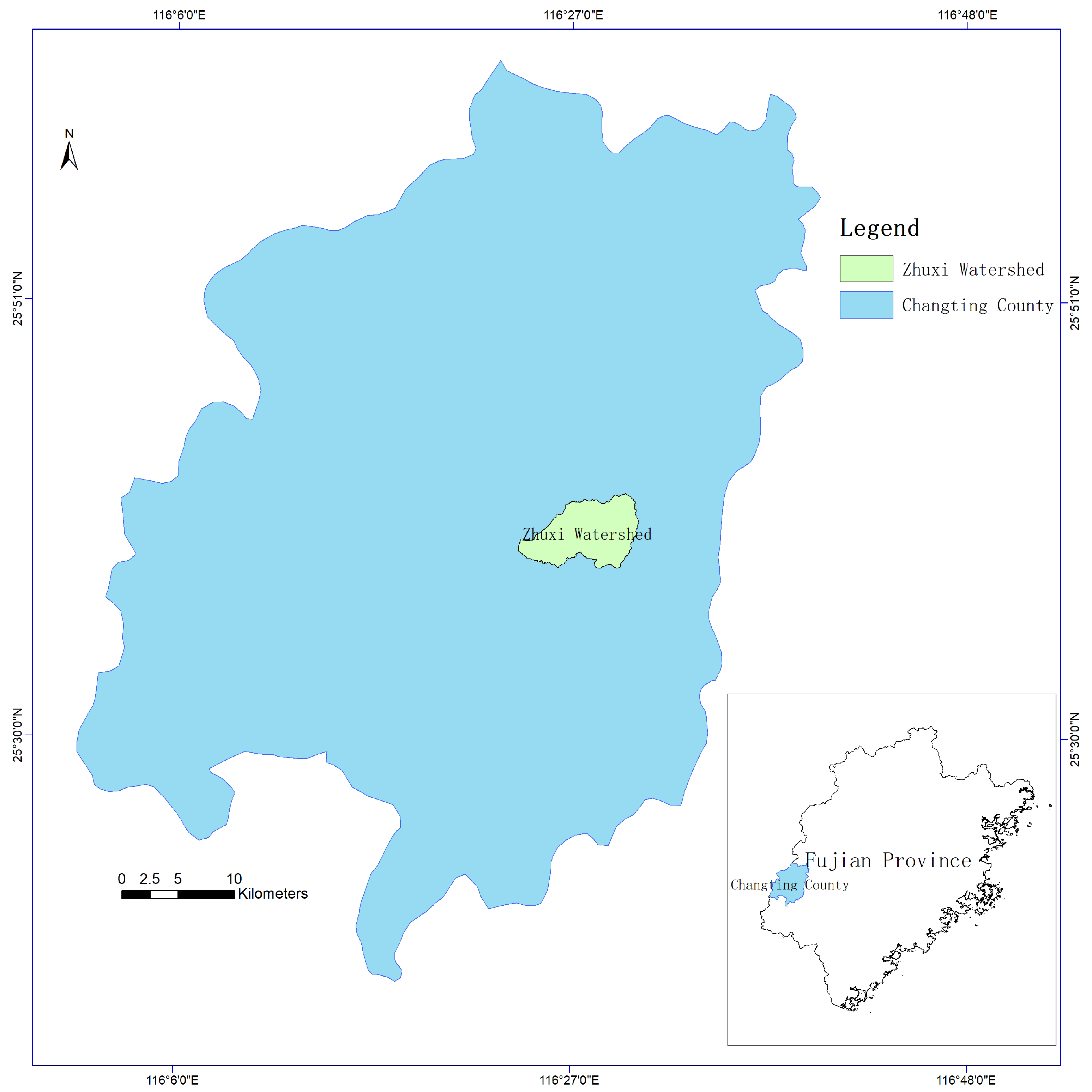
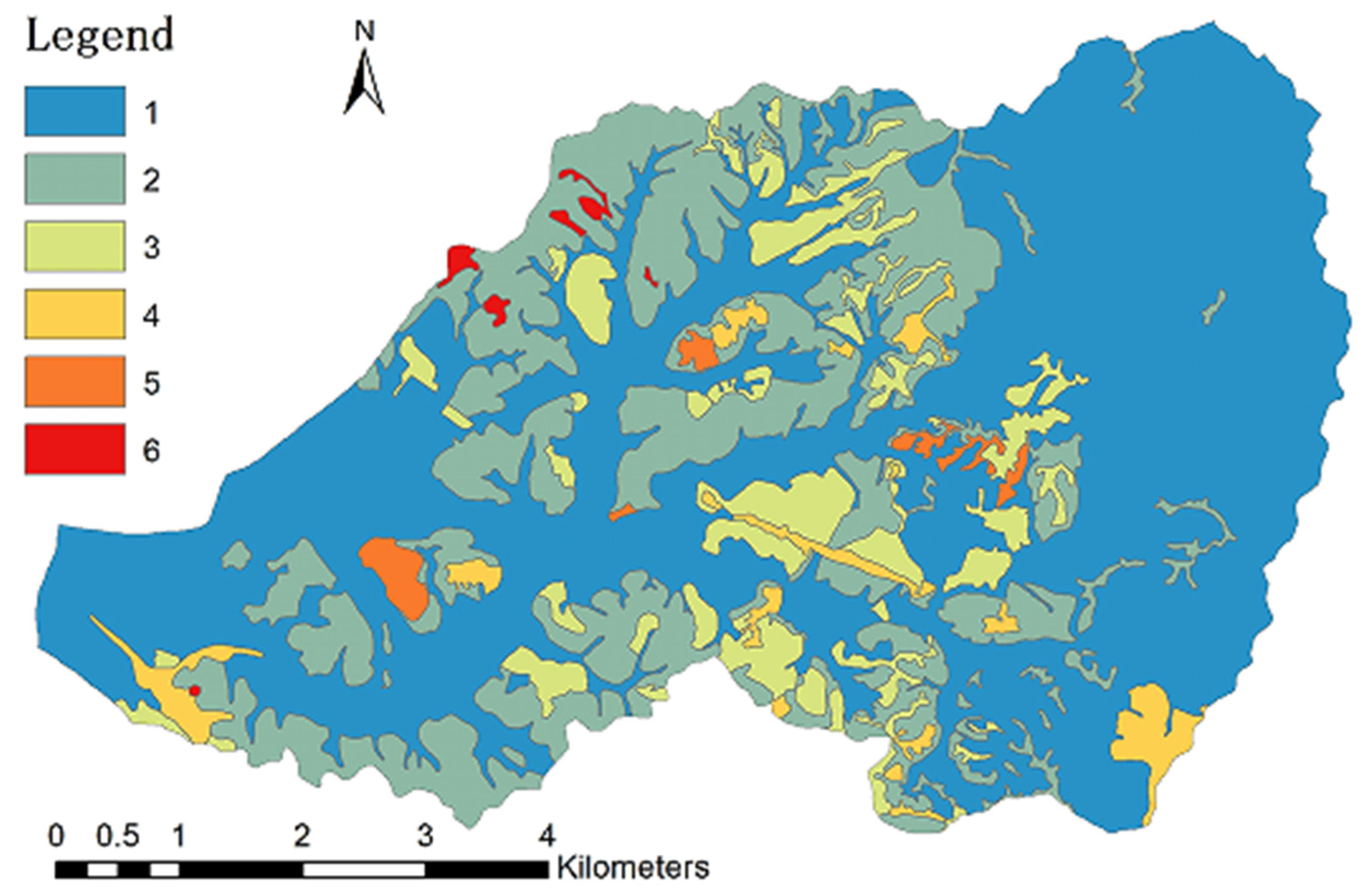
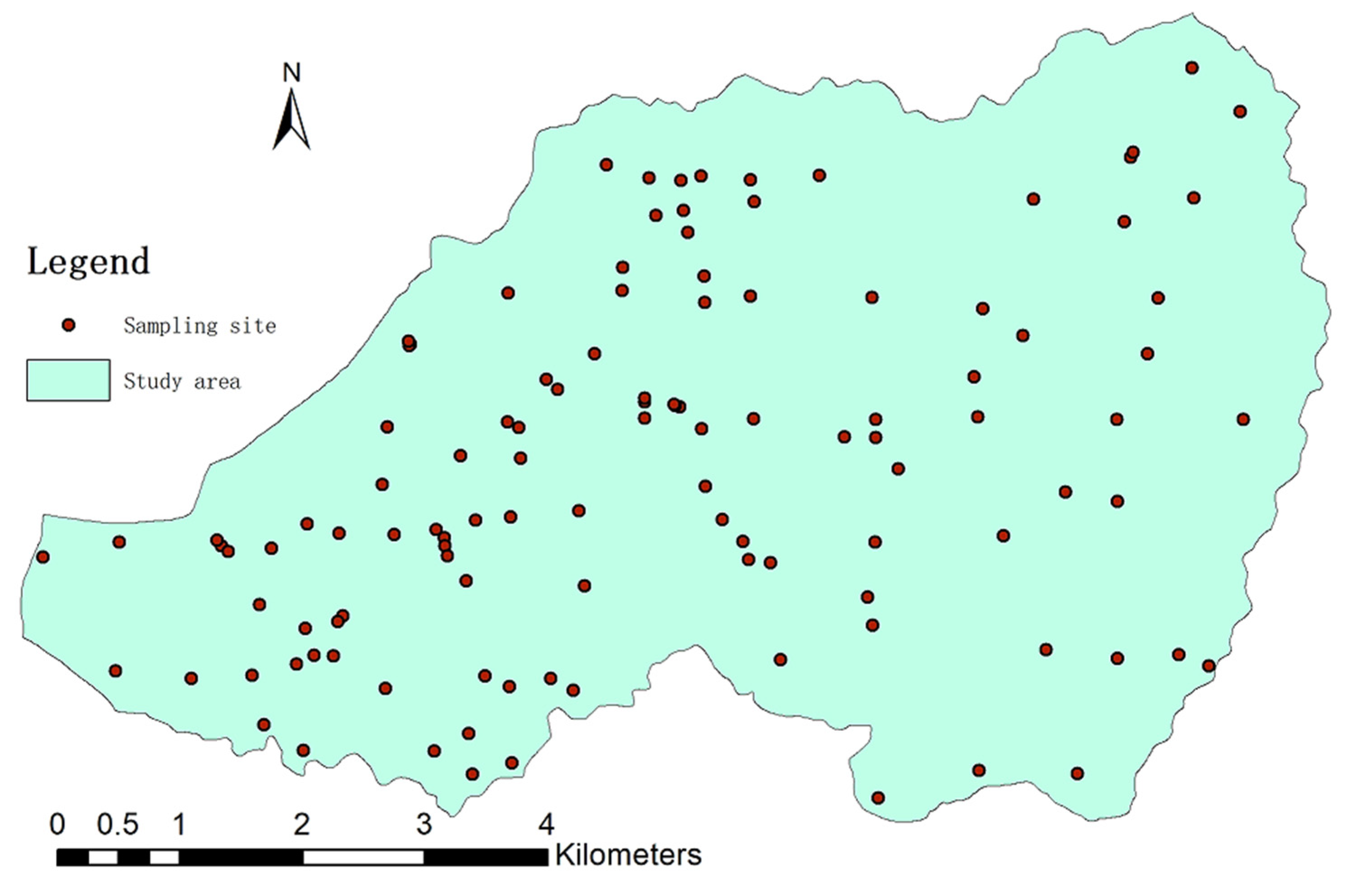


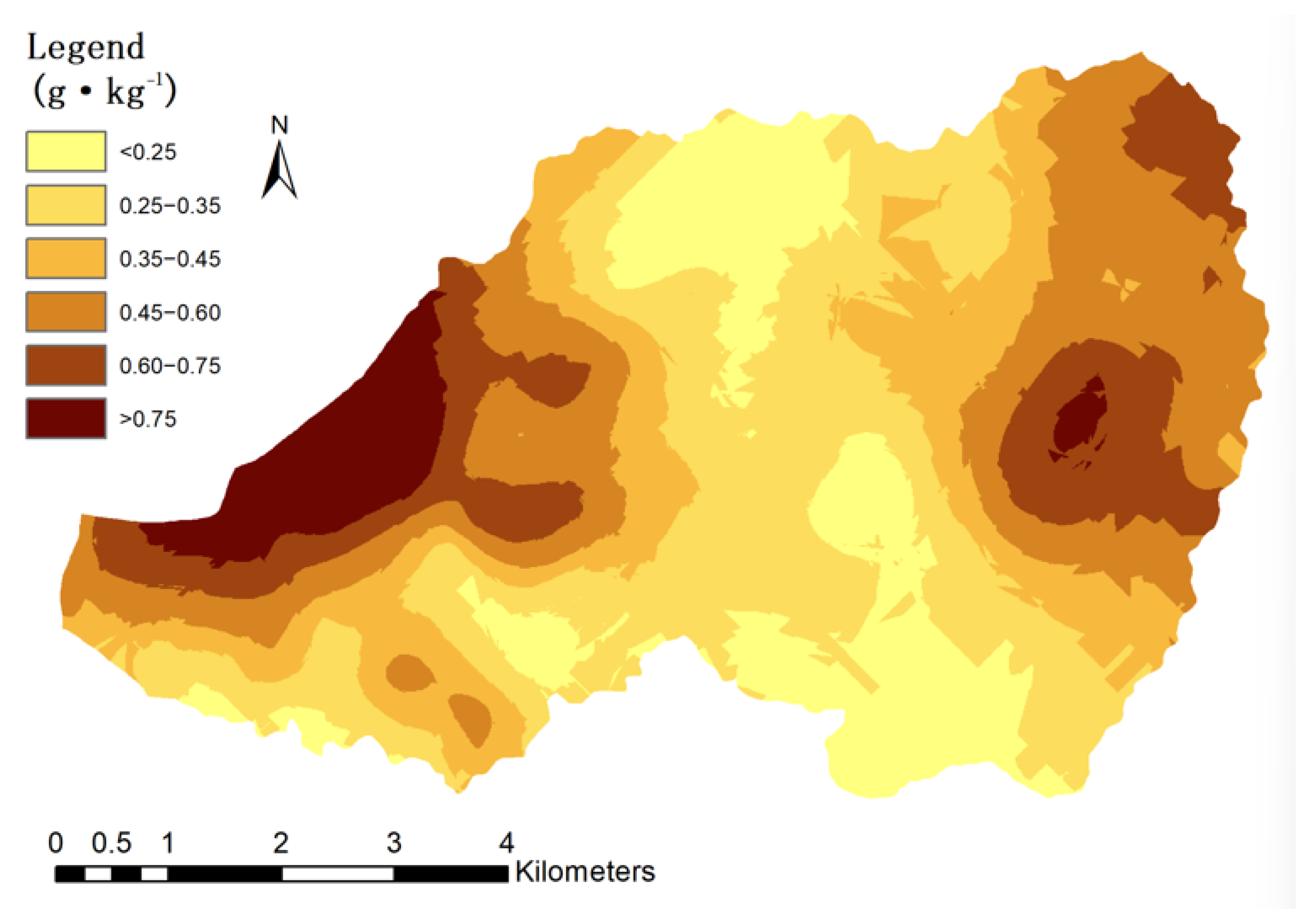
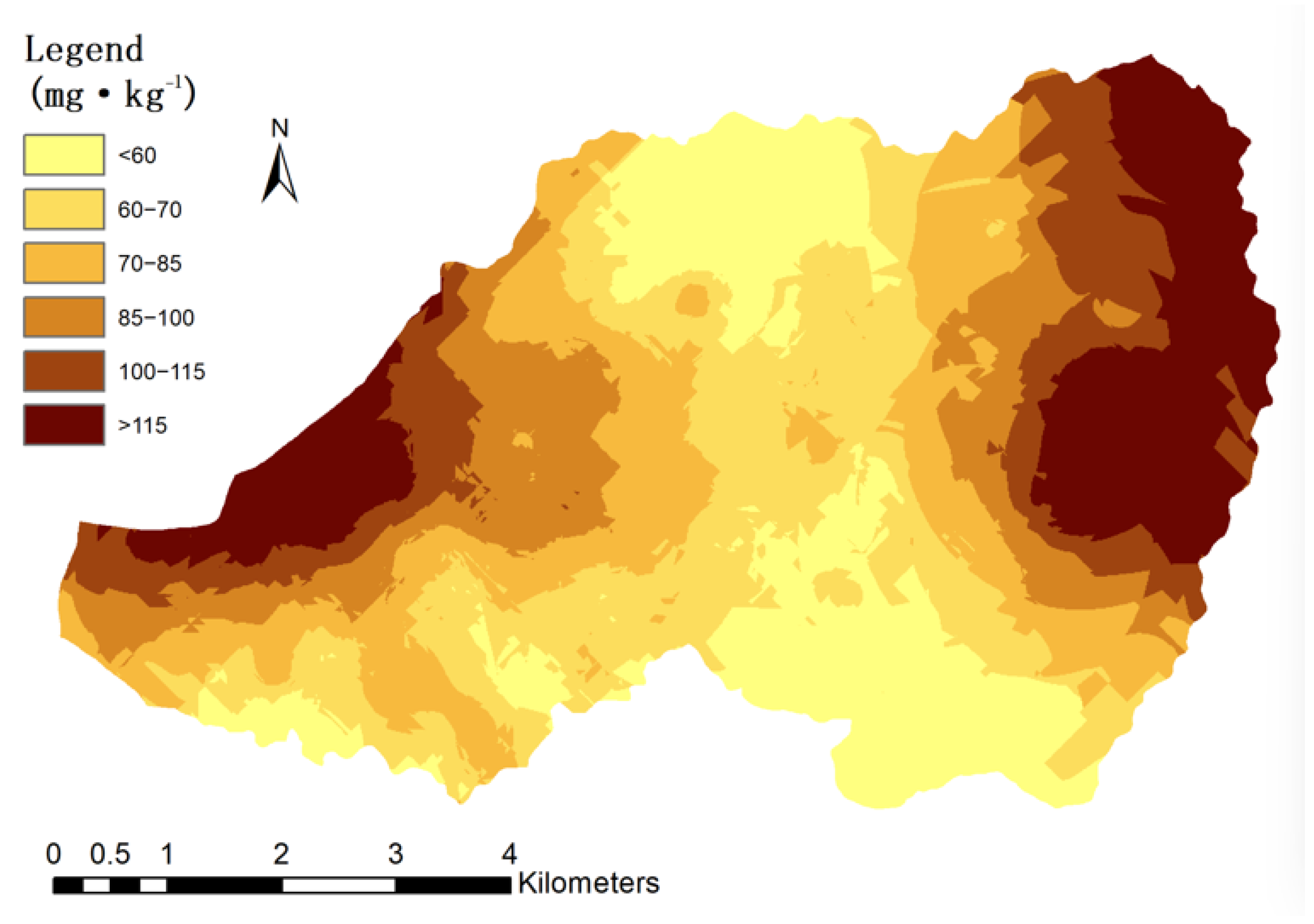
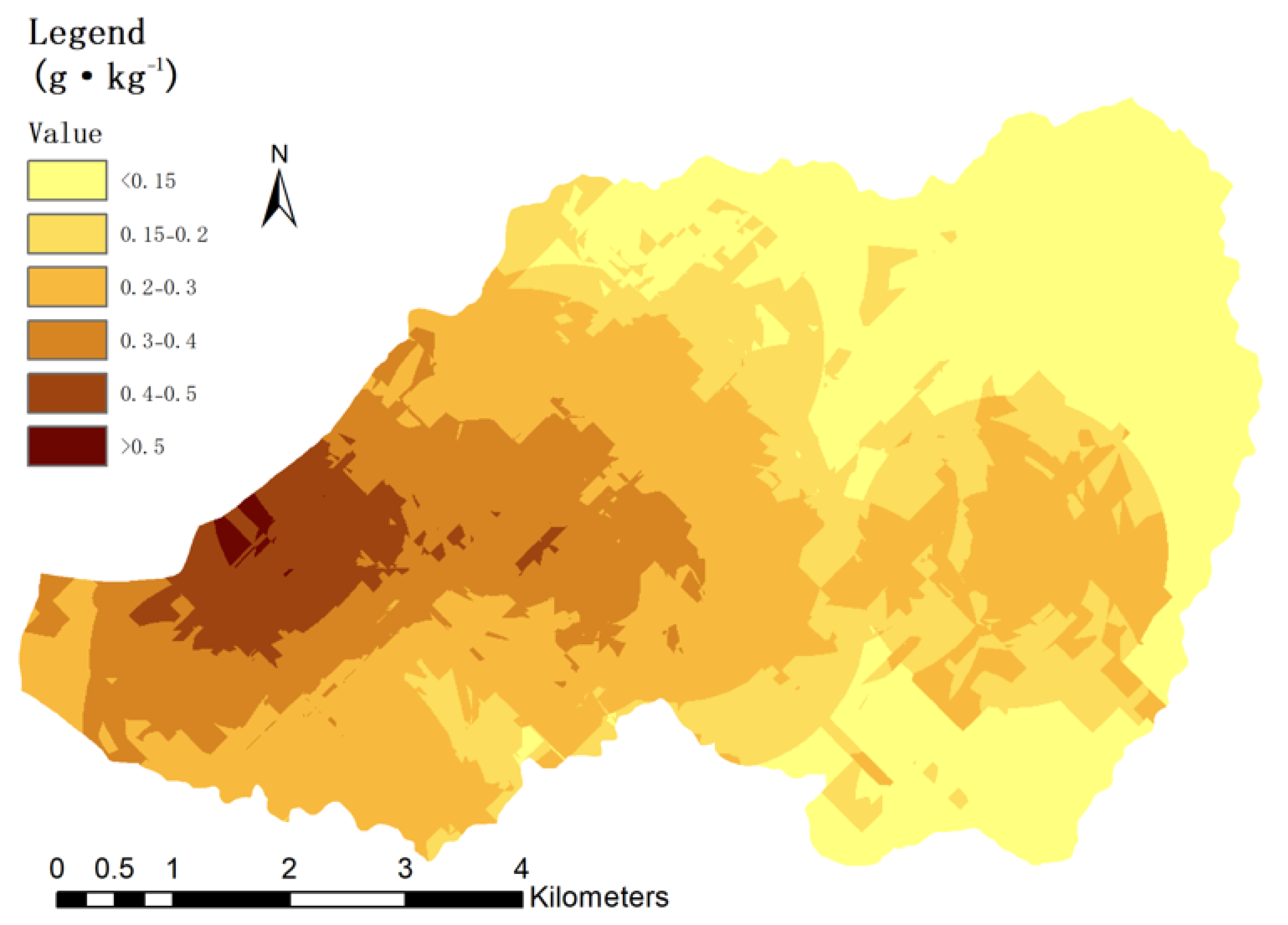
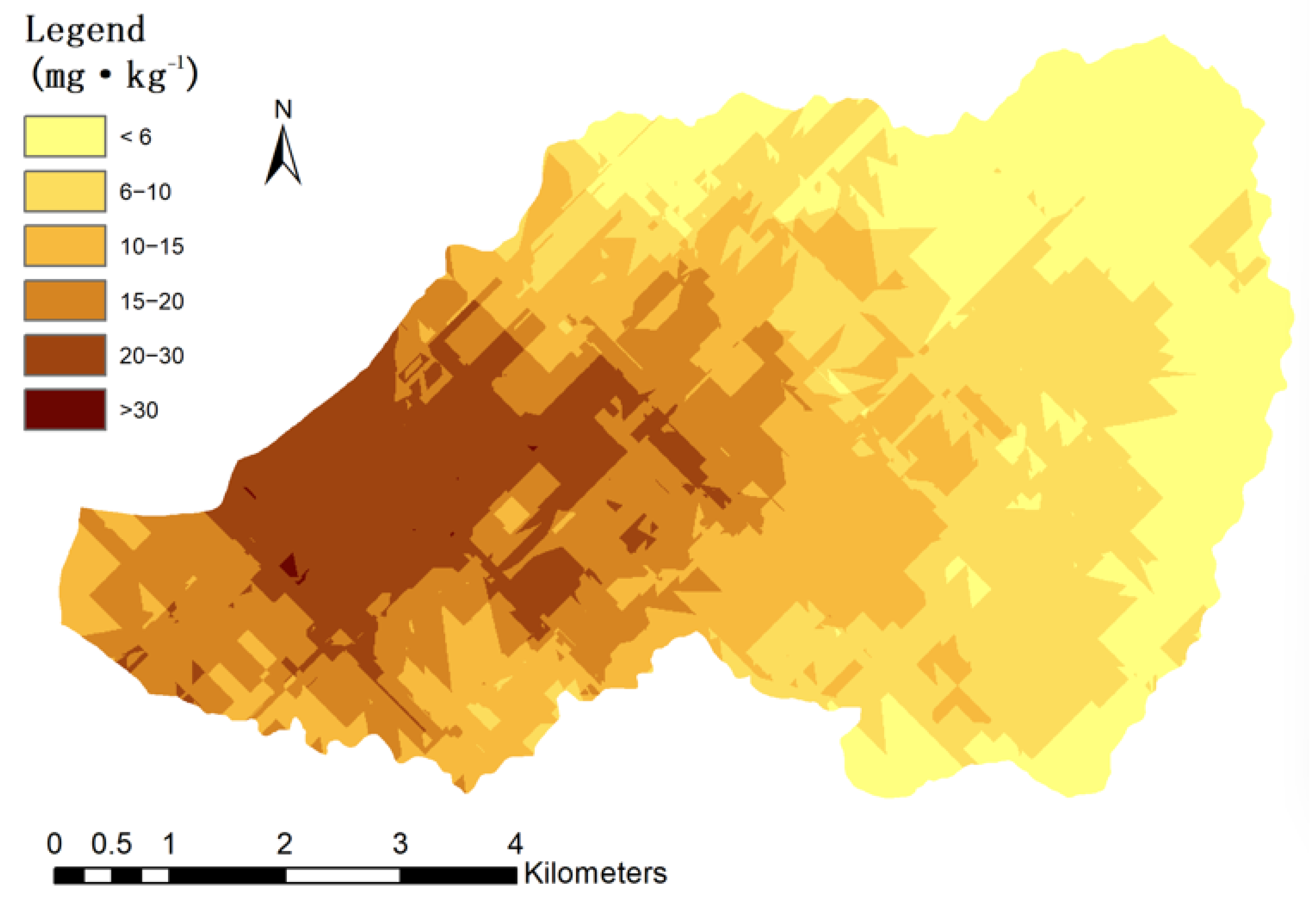
| Soil Erosion Type | Grade | Area (km2) |
|---|---|---|
| Slight erosion | 1 | 27.39 |
| Light erosion | 2 | 11.82 |
| Moderate erosion | 3 | 3.81 |
| Intense erosion | 4 | 1.28 |
| Extreme erosion | 5 | 0.47 |
| Severe erosion | 6 | 0.17 |
| Analysis Items | Analysis Methods |
|---|---|
| OM | High-temperature External Heating Potassium Dichromate Oxidation–Volumetric Method |
| TN | Kjeldahl Digestion Method |
| AN | Alkali Hydrolysis–Diffusion Method |
| TP | Sodium Hydroxide Fusion-Molybdenum–Antimony-Anti Colorimetric Method |
| AP | Double Acid Extraction-Molybdenum–Antimony-Anti Colorimetric Method |
| Item | Sample | Mean | Min | Max | SD | CV (%) | Skewness | Kurtosis |
|---|---|---|---|---|---|---|---|---|
| OM (g·kg−1) | 118 | 22.28 | 0.29 | 67.38 | 17.29 | 0.78 | 0.93 | 3.15 |
| TN (g·kg−1) | 118 | 0.42 | 0.04 | 1.3 | 0.34 | 0.81 | 0.78 | 2.51 |
| AN (mg·kg−1) | 118 | 79.98 | 15.25 | 230.38 | 50.75 | 0.63 | 0.70 | 2.52 |
| TP (g·kg−1) | 118 | 0.25 | 0.04 | 0.8 | 0.22 | 0.88 | 1.39/0.47 * | 3.46/2.34 * |
| AP (mg·kg−1) | 118 | 14.03 | 0.1 | 56 | 20.26 | 1.44 | 1.17/0.08 * | 2.59/1.86 * |
| Grade | OM (g·kg−1) | TN (g·kg−1) | AN (mg·kg−1) | TP (g·kg−1) | AP (mg·kg−1) |
|---|---|---|---|---|---|
| 1 | >40 | >2 | >150 | >2 | >40 |
| 2 | 30–40 | 1.5–2 | 120–150 | 1.5–2 | 20–40 |
| 3 | 20–30 | 1–1.5 | 90–120 | 1–1.5 | 10–20 |
| 4 | 10–20 | 0.75–1 | 60–90 | 0.7–1 | 5–10 |
| 5 | 6–10 | 0.5–0.75 | 30–60 | 0.4–0.7 | 3–5 |
| 6 | <6 | <0.5 | <30 | <0.4 | <3 |
| Item | Model | Nugget (C0) | Sill (C0 + C) | C0/(C0 + C) (%) | Range (m) | R2 |
|---|---|---|---|---|---|---|
| OM | Spherical | 151.94 | 294.70 | 0.52 | 2655.98 | 0.499 |
| TN | Spherical | 0.04 | 0.10 | 0.39 | 1422.39 | 0.805 |
| AN | Exponential | 1536.10 | 2726.00 | 0.56 | 5333.97 | 0.531 |
| TP | Spherical | 0.40 | 0.71 | 0.56 | 2422.90 | 0.698 |
| AP | Spherical | 357.24 | 470.81 | 0.76 | 844.50 | 0.699 |
| Item | Mean | Root Mean Square | Mean Standardized | Root Mean Square Standardized | Average Standard Error |
|---|---|---|---|---|---|
| OM | −0.15372 | 14.86525 | −0.00961 | 0.93063 | 16.14202 |
| TN | 0.00069 | 0.30685 | 0.00162 | 0.96273 | 0.32179 |
| AN | −0.48489 | 48.02672 | −0.00889 | 1.00767 | 47.52079 |
| TP | 0.00523 | 0.22142 | 0.02023 | 0.91748 | 0.24351 |
| AP | 0.01592 | 19.5293 | −0.00022 | 0.96872 | 20.20895 |
| Soil Erosion Grade | OM | TN | AN | TP | AP | |
|---|---|---|---|---|---|---|
| Soil erosion grade | 1 | −0.292 ** | −0.369 ** | −0.412 ** | 0.042 | 0.259 ** |
| OM | 1 | 0.782 ** | 0.796 ** | 0.315 ** | 0.149 * | |
| TN | 1 | 0.855 ** | 0.433 ** | 0.216 ** | ||
| AN | 1 | 0.389 ** | 0.163 * | |||
| TP | 1 | 0.757 ** | ||||
| AP | 1 |
Disclaimer/Publisher’s Note: The statements, opinions and data contained in all publications are solely those of the individual author(s) and contributor(s) and not of MDPI and/or the editor(s). MDPI and/or the editor(s) disclaim responsibility for any injury to people or property resulting from any ideas, methods, instructions or products referred to in the content. |
© 2025 by the authors. Licensee MDPI, Basel, Switzerland. This article is an open access article distributed under the terms and conditions of the Creative Commons Attribution (CC BY) license (https://creativecommons.org/licenses/by/4.0/).
Share and Cite
Chen, H.; Fang, S.; Lin, G.; Shangguan, Y.; Cao, F.; Chen, Z. Spatial Distribution Characteristics of Soil Nutrients in the Ferralic Cambisols Watershed. Nitrogen 2025, 6, 77. https://doi.org/10.3390/nitrogen6030077
Chen H, Fang S, Lin G, Shangguan Y, Cao F, Chen Z. Spatial Distribution Characteristics of Soil Nutrients in the Ferralic Cambisols Watershed. Nitrogen. 2025; 6(3):77. https://doi.org/10.3390/nitrogen6030077
Chicago/Turabian StyleChen, Haibin, Shengquan Fang, Gengen Lin, Yuanbin Shangguan, Falian Cao, and Zhibiao Chen. 2025. "Spatial Distribution Characteristics of Soil Nutrients in the Ferralic Cambisols Watershed" Nitrogen 6, no. 3: 77. https://doi.org/10.3390/nitrogen6030077
APA StyleChen, H., Fang, S., Lin, G., Shangguan, Y., Cao, F., & Chen, Z. (2025). Spatial Distribution Characteristics of Soil Nutrients in the Ferralic Cambisols Watershed. Nitrogen, 6(3), 77. https://doi.org/10.3390/nitrogen6030077







